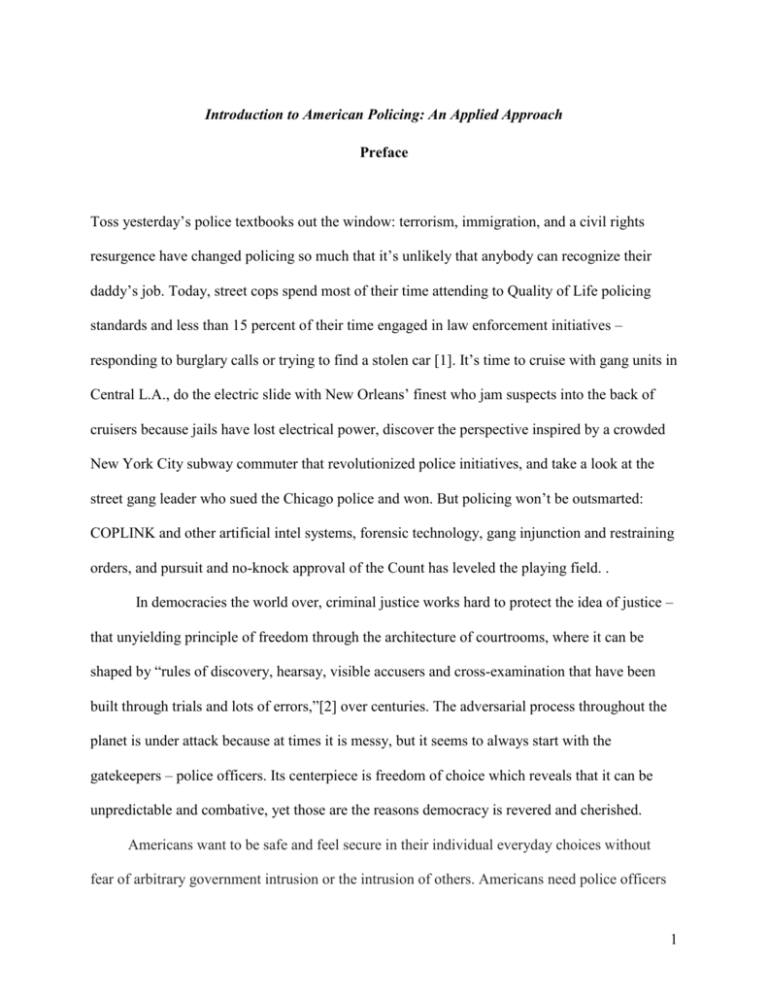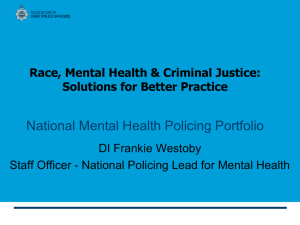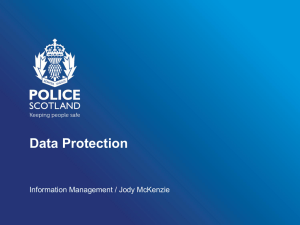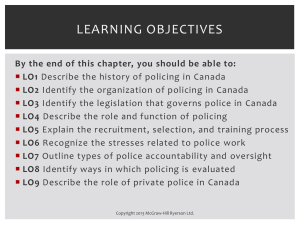Introduction to American Policing: An Applied Approach
advertisement

Introduction to American Policing: An Applied Approach Preface Toss yesterday’s police textbooks out the window: terrorism, immigration, and a civil rights resurgence have changed policing so much that it’s unlikely that anybody can recognize their daddy’s job. Today, street cops spend most of their time attending to Quality of Life policing standards and less than 15 percent of their time engaged in law enforcement initiatives – responding to burglary calls or trying to find a stolen car [1]. It’s time to cruise with gang units in Central L.A., do the electric slide with New Orleans’ finest who jam suspects into the back of cruisers because jails have lost electrical power, discover the perspective inspired by a crowded New York City subway commuter that revolutionized police initiatives, and take a look at the street gang leader who sued the Chicago police and won. But policing won’t be outsmarted: COPLINK and other artificial intel systems, forensic technology, gang injunction and restraining orders, and pursuit and no-knock approval of the Count has leveled the playing field. . In democracies the world over, criminal justice works hard to protect the idea of justice – that unyielding principle of freedom through the architecture of courtrooms, where it can be shaped by “rules of discovery, hearsay, visible accusers and cross-examination that have been built through trials and lots of errors,”[2] over centuries. The adversarial process throughout the planet is under attack because at times it is messy, but it seems to always start with the gatekeepers – police officers. Its centerpiece is freedom of choice which reveals that it can be unpredictable and combative, yet those are the reasons democracy is revered and cherished. Americans want to be safe and feel secure in their individual everyday choices without fear of arbitrary government intrusion or the intrusion of others. Americans need police officers 1 to effectively deal with the intruders and protect their freedom at the same time. Herein lays the incredible challenge of policing – balance apprehension versus rights. Every day, police face new legal, economic, and managerial challenges, yet are faced with inadequate budgets and an ever increasing demand for quality police services including a host of new responsibilities such as homeland security and immigration. Americans insist that police shield them from crime and the collateral damage of terrorism, natural calamities, and epidemics. Yet, law makers and, yes, law-breakers, too, demand their rights as provided by the U.S. Constitution. When individuals feel violated, public sentiment rushes them into the streets and the courtrooms. One way to learn about public safety and freedom is through this Introduction to American Policing: An Applied Approach textbook because it provides a balanced investigation of police history and theory linked to police practice to enable a student to make an informed decision about the issues. It is clear that when human rights are safeguarded through professional police initiatives, the less anarchy and government corruption exists [3]. This compelling argument is evidenced among Americans who enjoy a steady rise in their quality of life experiences which includes influencing decision making routines of police behavior through leadership, practical police knowledge, evidence-based policing, litigation, and oversight activities. This process is the benchmark of a democracy as is police accountability. Another attempt of this textbook is to explain policing from the inside of policing through the personal experiences of officers and link their experiences to scholarly research. However, as we proceed through the pages ahead, be mindful that contemporary history is the hardest to write, but the easiest to criticize. This Introduction to American Policing: An Applied Approach will describe the criminal justice, criminology, and law enforcement knowledge and connect the dots linked to the progress 2 of the police community. It will satisfy scholars who lean toward theoretical perspectives and practitioners alike because it includes investigative reports about police organizations, case studies, narratives from violators, and current research and impressions from colleagues, officers, and researchers. This technique results in a blend of theory and practice that prompts reader participation by probing the way some believe policing ‘should be’ while examining evidence about the ‘way it is.’ After reading this textbook, readers will recognize the central theories and practical realities of American law enforcement and Quality of Life practices. Then, too, because of the frequent partnerships of local and state police organizations with federal organizations, [4] an Introduction to American Policing: An Applied Approach provides a current description of those partnerships and of the efforts accomplished by federal law enforcement agencies including the Department of Homeland Securities (DHS). The goal of this book is to help a reader think for himself or herself, to understand, to imagine, to reflect, and to exercise good judgment associated with the principle issues related to American policing. That is, to provide relative theoretical scholarly perspectives and practical police experiences to help a reader make an informed decision about policing in this new millenium. Dennis J. Stevens Fairfield, Connecticut [1] Peter K. Manning ((1995). The police: Mandate, strategies, and appearances. In Victor E. Kappeler (Ed.) The police & society: Touchstone readings. (pp. 97-126). Mt. Prospect, IL: Waveland Press. [2] Ron Suskind (2006, September 18). The unofficial story of the al-Qaeda 14. Time. P. 34. 3 [3] This is a perspective advanced in: Dennis J. Stevens (2007). Police stress: Its origins and what to do about it. Upper Saddle River, NJ: Prentice Hall. [4] Robert Michael Goldman (2001). A Free Ballot and a Fair Count: The Department of Justice and the Enforcement of Voting Rights. NY: Fordham University Press. 4









